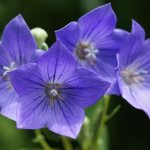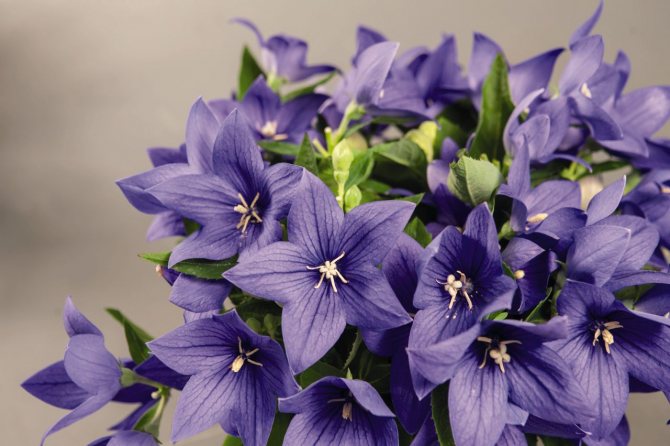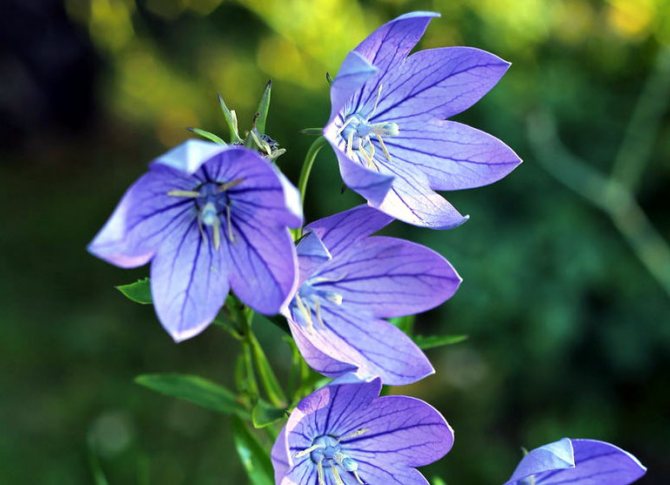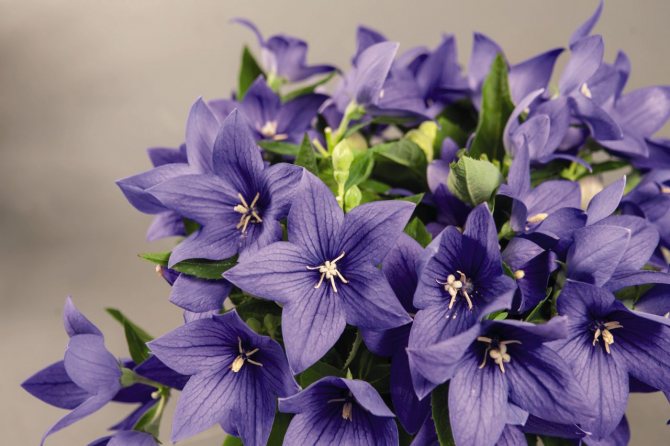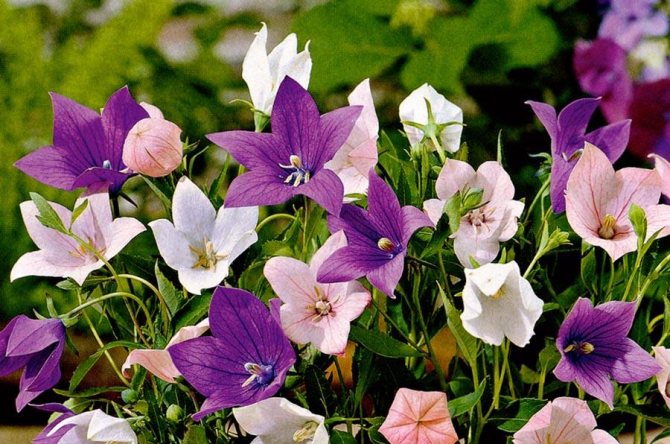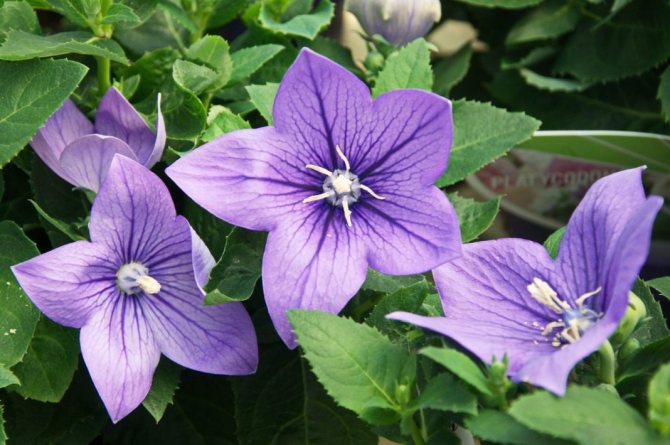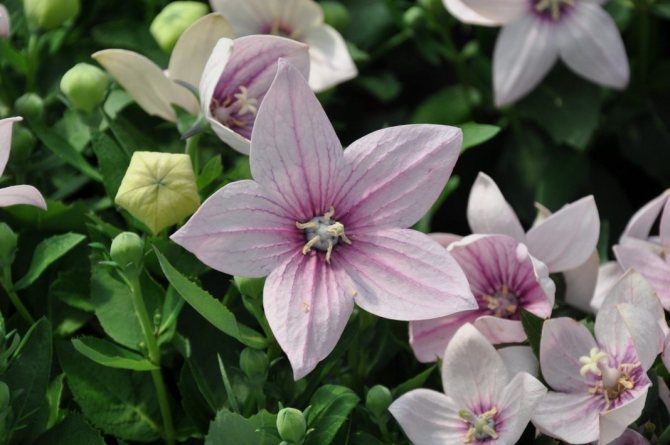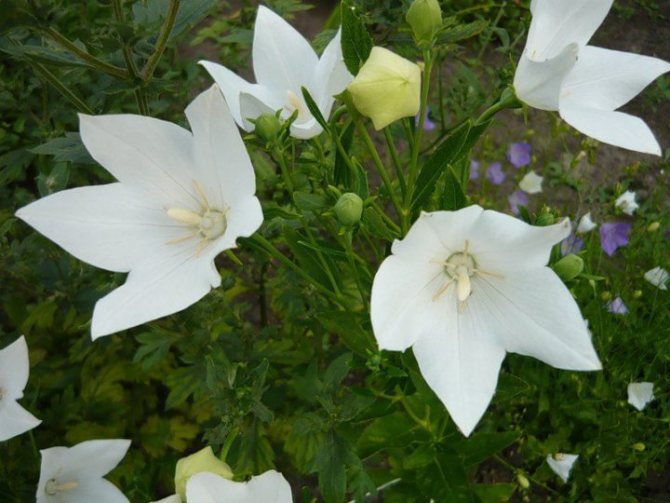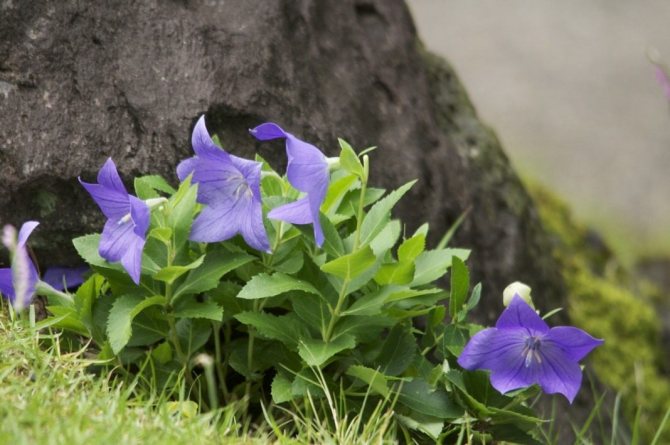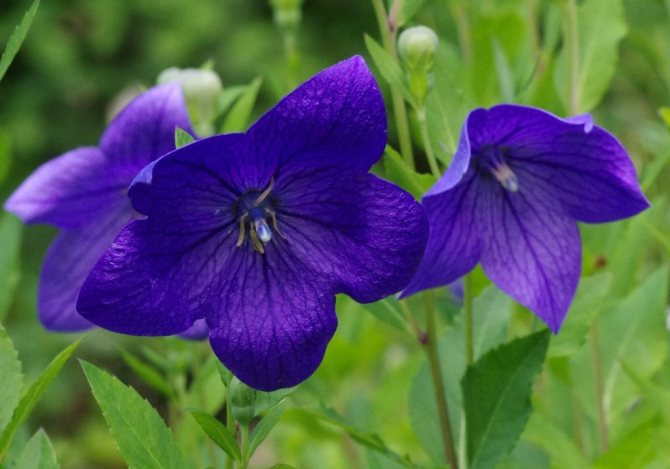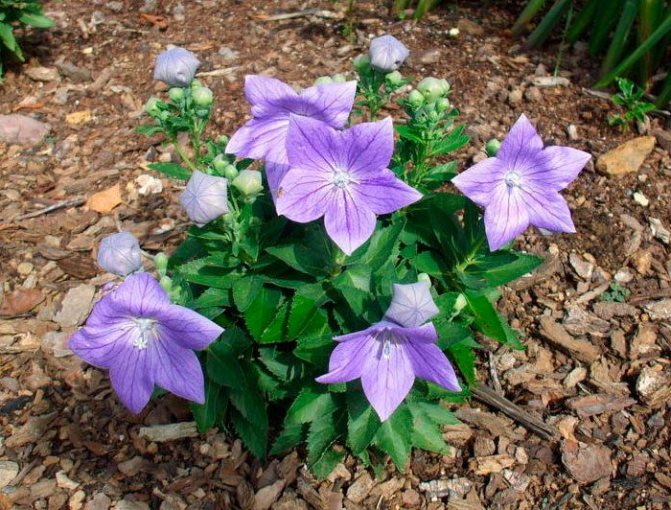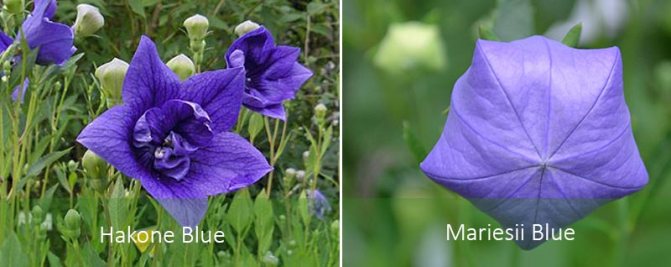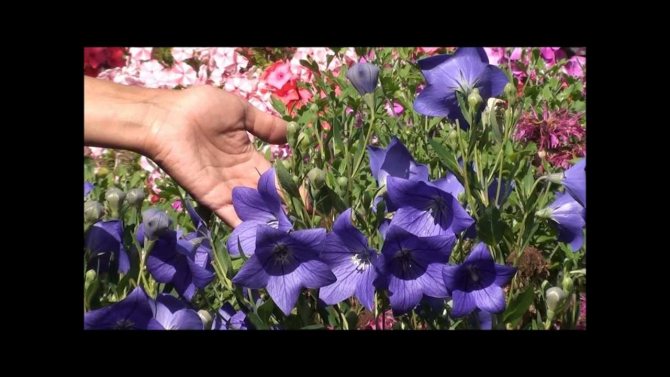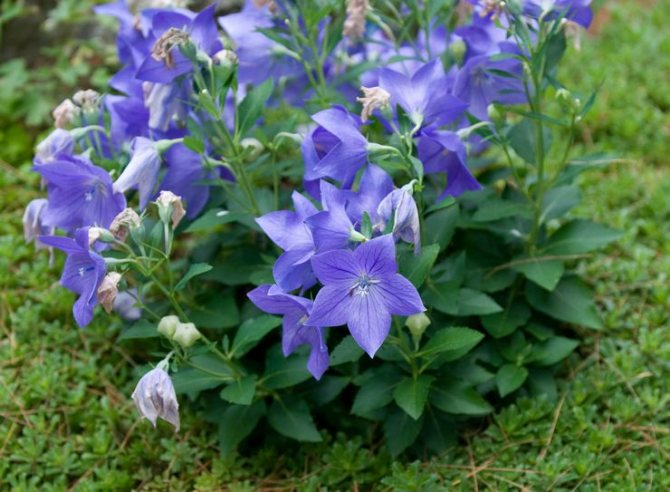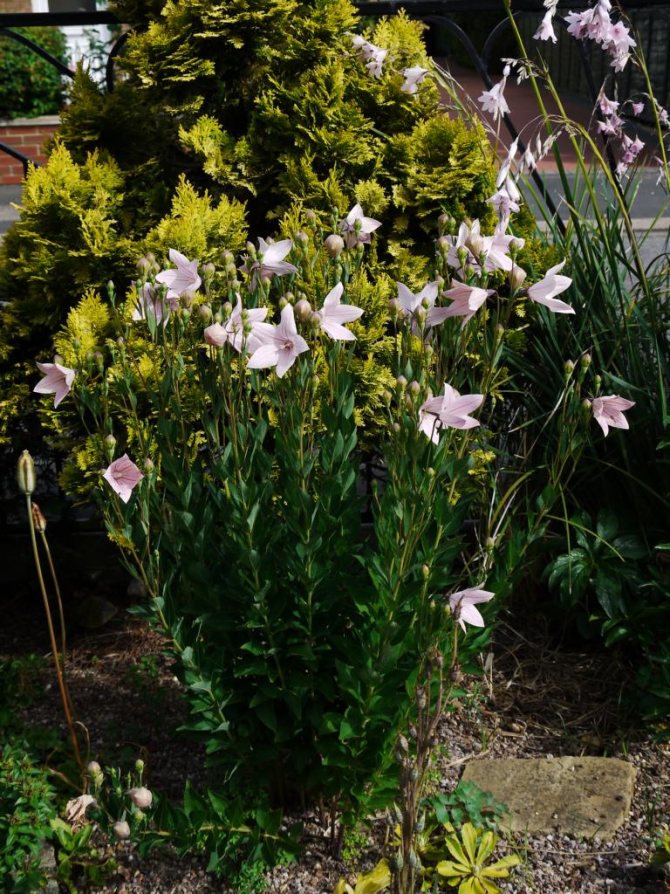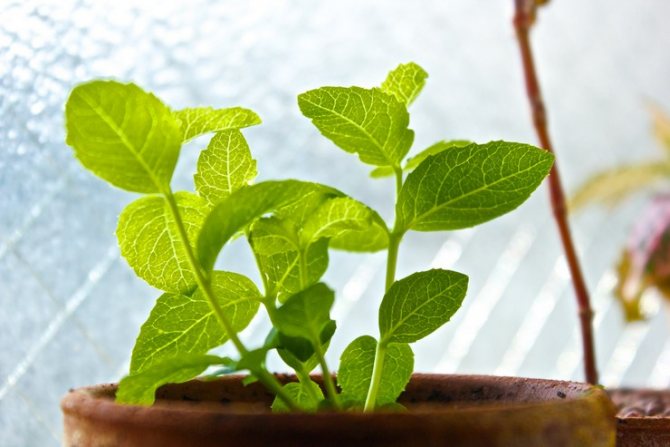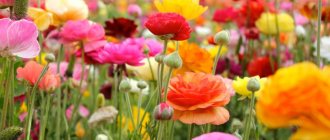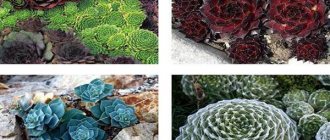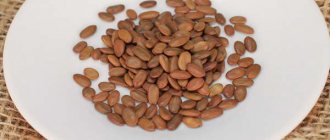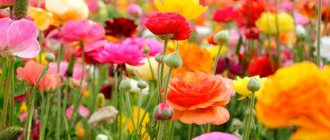Flower characteristics
The platycodon bell belongs to the Kolokolchikov family. It can be found not only in Russia, but also in Korea, China, Japan. The plant gained particular popularity in the XX century.
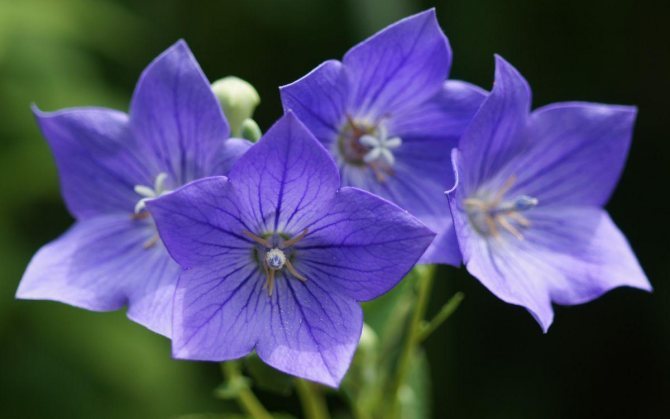
Bright and large flowers immediately attract attention
If the flower is grown correctly, then it reaches a height of 1.2 m. The rhizome is represented by a large bulb. The leaves are elongated. Flowers can reach a length of 8 cm. They are collected in inflorescences or grow singly.
Platycodon - oriental flower
Japan is considered the birthplace of the magnificent bell, as well as the Ussuri region, Manchuria and China. Nevertheless, he perfectly took root in European gardens. In central Russia, gardeners observe the emergence of shoots from the ground in the 2nd half of May. And it blooms in July-August.
Just as there is no oriental Platicodon flower, which amazes the imagination with its variety of shapes and shades of petals. Its color ranges from white to purple. Light petals are pierced with blue veins, and, for example, large-flowered platycodon (dwarf "Hanus Pink") shows a bright pink hue. The most popular varieties are:
- Fuji White and Fairy Snow (white);
- Fuji Blue (blue);
- Fuji Pink (platycodon pink);
- "Alba Plena" and "Captivity" - terry platycodon white and blue;
- "Bumilus" is purple.
All varieties are divided into ordinary and dwarf. Ordinary stems are very unstable. At dense planting of mixborders, “smoothing” occurs. If the flower is planted far from other plants, the stems will have to be tied up. Dwarf large-flowered varieties are devoid of such a drawback. Among them are Alpinus (30 cm), Apoyama (25-30 cm), Pumilus (15 cm), Hanus (15 cm). Beautiful "Hanus Alba" and "Hanus Pink" with white and pink inflorescences, respectively.
Platicodon - description
Outwardly, this plant looks like ordinary bells, but it has a number of special features:
- Platycodon is characterized by a fleshy rhizome, thin and straight roots reaching a height of 20-80 cm and opposite leaves of an ovoid or elongated shape.
- Platycodon at home or on the street has a bluish color of stems and leaves.
- As for the flowers, they can be single or collected in panicles of several pieces. They are also large and reach a diameter of up to 8 cm.Depending on the variety, the color of the buds differs.
- Flowering is observed for two months, starting in mid-July. After that, the fruit is formed - an ovoid capsule, in which there are flat and shiny ovoid seeds.
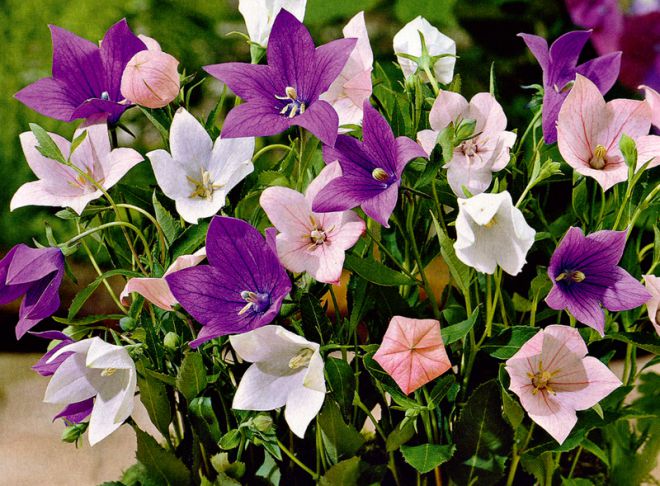

Platycodon varieties
Actually, in the genus Platycodon there is only one species - Platycodon, or large-flowered bellflower (platycodon grandiflorus).Which does not mean at all that this plant is boring and one-faced. Platycodon has many very beautiful varieties that differ not only in color.
The best shirokolokolchikam are boldly ranked as:
- "Album" variety with luxurious white flowers, decorated with thin blue veins and powerful clumps up to 60 cm high;
- form "Nanum" with low bushes and touching periwinkle-blue star-shaped flowers with dark veins;
- undersized, up to 35 cm in height, variety "Marisil" with a light blue color;
- light blue, with white buds, the "Sentimental Blue" variety;
- variety "Apoyama" - a dwarf about 20 cm high with a carmine, rich-dark color, more suitable for rocky gardens;
- Pléno form with double dark blue flower;
- Pleno Alba shape with a double snow-white flower and very beautiful stamens;
- variety "Fuji Pink" with loose, sprawling clumps and large star-shaped bells of a delicate white-pink color;
- semi-double variety with sparkling snow-white flowers "Snowflakes";
- "Mother of Pearl" - standard height pink bell;
- grade "Perlmutterschale" with a pearlescent texture of pale pink flowers.
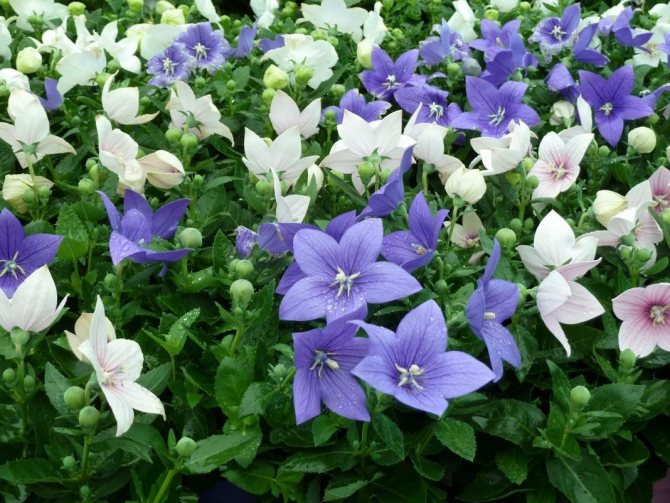

Platycodons, or Shirokokolokolchiki. <>
A wide bell in landscape design is used as:
- a plant for spectacular spots on the lawn or meadows with ground covers;
- a large-colored bell in landscape-type compositions;
- to create spectacular compositions on flower beds and in flower beds, decorated in a cold range;
- highlighting accent in large flower beds;
- partner plant for showy roses and other big soloists;
- in compositions with a continuous flowering relay;
- in compositions from bells;
- in textured flower beds;
- a cutting plant (pruning into bouquets is carried out only when all the flowers on a branch have opened).
The best partners for Platicodone: all bells, phlox, gypsophila, adenophore.
Planting Platicodon in open ground
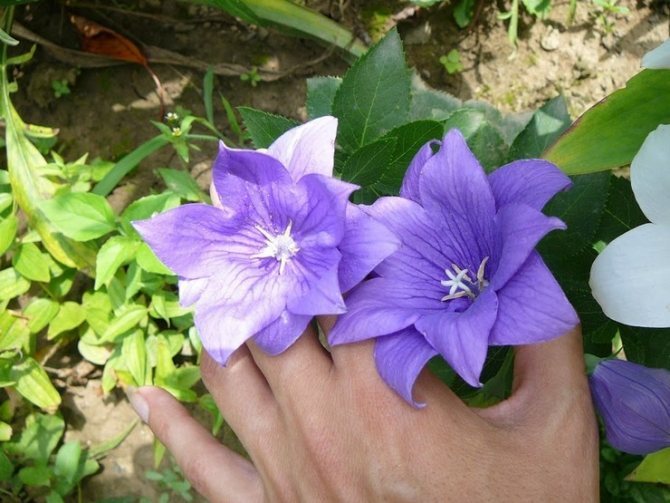

When to plant platycodon
The ideal time for transplanting seedlings to open flower beds is the third decade of May or the first decade of June. Even mild night frosts can significantly harm young plants, so you should wait for stable warm weather.
It is better to choose a site for planting in an open, illuminated place or in a light partial shade. Good drainage is recommended. The soil should be nutritious and loose with moderate moisture, neutral in composition. It can be loam or fertile soil with a small addition of sand and deep groundwater. Before planting, the site must be dug up, adding wood ash and mineral fertilizers during digging. For each square meter of land, you will need a tablespoon of complex fertilizing and half a glass of ash.
It is necessary to choose such a place for the Platycodon, where he will feel great for a long time without transplants (he does not like such procedures). On average, a plant can fully develop in one area for about ten years.
How to plant Platicodon correctly
The planting holes are located at a distance of about 30 cm from each other, the volume of each of them depends on the size of the root part of the plant. The depth and width of the hole should slightly exceed the size of the earthen ball of seedlings. Young plants are watered before being removed from the pots, and then, together with a clod of earth, are transferred into the planting hole. After filling the hole with earth, the first watering is carried out.
Conditions comfortable for platycodons
If you want to admire the luxurious flowering of Platycodon, try to provide it with a sunny location or at least a bright location. The shirokokolokolchik does not like shadows, it stretches slightly in light shading. But in fact, it is a much more adaptive plant than campanula.In many ways, the range of comfortable lighting for Platicodon is determined by how the seedlings or plant cuttings were grown. Therefore, it is better to clarify the lighting parameters when buying: if young platycodons have been adapted to shading, and in the garden they will be able to settle in more secluded places.
Soil selection can be given less attention. For Platycodon, only one soil parameter is critical - drainage. In order for a plant to successfully winter, grow rapidly and bloom, it must be protected from even the minimum risk of stagnant water. In places with moist, dense soil, where there is a high risk of stagnation of rainwater or the level of occurrence of groundwater, it is better to lay a drainage layer at the bottom of the planting pits.
Platycodons are quite resistant and reliable plants. They grow in one place without losing the abundance of flowering for 5-6 years, they can be replanted every 7 years.
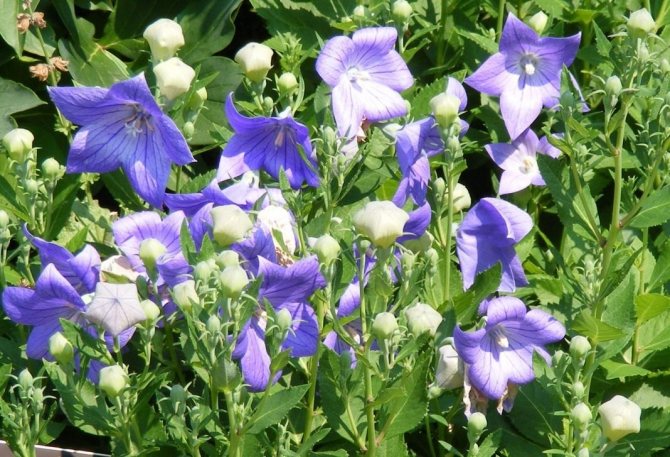

Platycodon grandiflorus ‘Sentimental Blue’ variety. <>
Watering
Phlox paniculata: varieties, planting and care
After planting flowers, you need to create the right conditions for the seedlings. For the first two weeks, they are watered every day. Then the regime is changed and the number of watering is reduced to 1 time in three days.
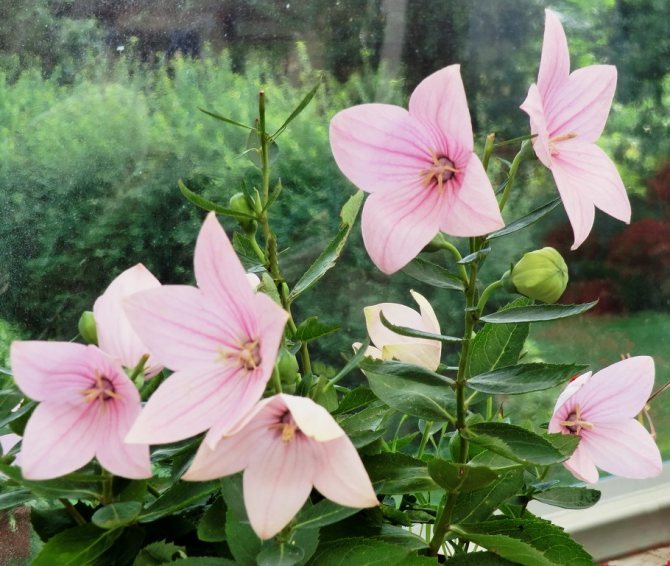

The abundance of moisture is important for plant life and active growth.
You need to loosen the soil after each watering. Platycodon flowers need constant oxygen supply. In the process of digging up the soil, weeds can be removed.
Watering and loosening the soil
Hydrangea Dubolistnaya - winter-hardy varieties, planting and care
Platycodon is a perennial flower that is unpretentious in cultivation, but in order for the bush to please with its flowering for a long time, it is necessary to water it in a timely manner. It generally tolerates dry summers well. But occasionally the bells are irrigated. It is especially important to monitor soil moisture during the budding period. In other cases, watering is carried out only after it has been noticed that the topsoil is completely dry.
When planting a bell, the ground should be loose and drainage. For this, a mixture is prepared: humus, compost, peat and foliage. All ingredients are mixed in equal amounts. By mulching, they regulate the acidity of the soil.
Plant care
In the first week after transplanting (in the event that you planted a flower in a seedling way), young bushes must be poured every day, but only if there is no rain. Over time, the amount of watering should be reduced. An adult plant should be watered only in the case of a dry hot summer. If you think this is not enough, you can spray the plant with a spray bottle. Platycodons bloom long and profusely. At the end of flowering, remove the wilted stalks, and the plant is likely to please you with a second flowering.
So that the bushes do not stretch up more than necessary, and do not lose their beautiful compact appearance, and this usually happens from the third year, you can treat the flowers with an inhibitor. This is best done in early spring.


Adult Platycodone does not need watering
For the winter, the plant is not pruned. But it is recommended to cover the platycodon if winters are frosty and snowless. Both branches of conifers and leaves or peat are suitable. The further north the region of residence, the thicker the cover layer should be. In the spring, the plant must be cleaned of old leaves.
Reproduction methods
Barberry shrub - species, varieties, planting and care
Platycodon flower can be propagated by several methods, the most common is the generative method. Seeds are sown in specially prepared soil. They monitor compliance with the technology. As soon as the seedlings germinate, they are planted in the required place. Another method of propagation is by cuttings, but if there is no experience in gardening, then it is better not to use it.
If bells grow on sandy soil, then they are propagated by dividing the bushes. In this case, they carefully dig out the bush and divide it into several bushes with a knife. The shoots should be with buds. In this case, the bush will accept and will delight with abundant flowering.
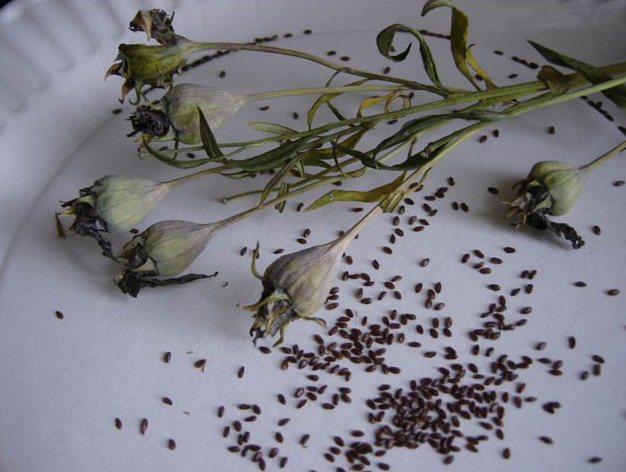

Plant propagation by seeds
Transfer
Platycodon plant cultivation, which is not subject to everyone, does not require frequent transplants. In one place, the flower grows beautifully for 10 years.
When in indoor conditions, large bells require a little different care. Young specimens are transplanted annually, adults every three years.
Platycodon is a perennial plant, therefore, if it dries quickly, this indicates errors in the content. With a properly organized rest period, the flower will delight the eye with its flowering for a long time.
Some gardeners prefer to grow Platycodon as an annual, but that doesn't make sense.
Pruning Platicodon
Platycodon plant, if not pruned, will eventually lose its attractive shape. To avoid this, the bush is pinched and treated with a special agent that slows down growth.
Worth knowing! Bush pruning is carried out twice a year - in spring and autumn. If the bush is very long in growth, it is tied to some kind of support.
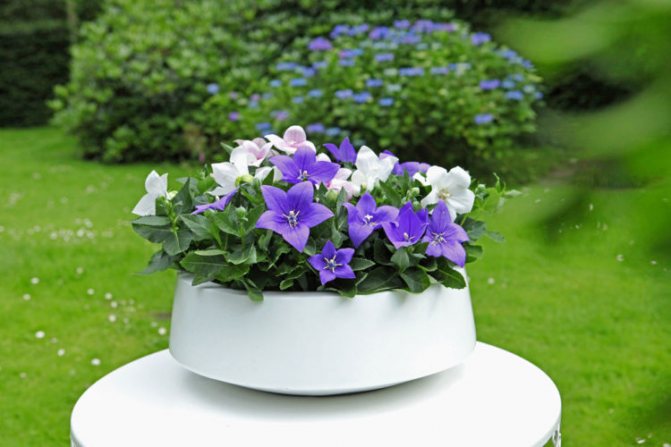

Perennial formation
Flowering period and care during this period
Platycodon is a perennial plant that pleases the eye with bright and large flowers that bloom at the top of the bush either singly or in groups. The bud is slightly inclined downward due to the short and flexible peduncle.
In appearance, it is similar to a bell, because all the petals are connected in one place. Among the whole variety of varieties, semi-double species are popular, the petals of which are arranged in several tiers. It is not difficult to take care of the plant during flowering.


Incredibly beautiful perennial flowering
Features of Platicodon
Platycodon's rhizome is fleshy, and the height of its straight, thin, densely leafy shoots can vary from 0.2 to 0.8 m. Opposite leaf plates have an elongated narrow or ovoid shape, as well as a finely toothed edge. The leaves located at the bottom are part of the root rosette. Leaf plates and shoots have a light bluish tint. Flowers can be single or 3-5 pieces collected in panicle inflorescences. The wide-open flowers are rather large, they can reach 8 centimeters in diameter, on the surface of the blue petals, a network is clearly visible, consisting of thin veins of dark color. There are forms, the color of the flowers in which can be white or dark purple. Externally, the swollen buds of such a plant are very similar to lanterns. Flowering lasts about 8 weeks and begins in the second half of July. The fruit is an ovoid capsule containing glossy flat egg-shaped seeds. It is recommended to grow such a flower in the garden together with a tall bell, gypsophila or undersized phlox.
Pruning
Even in a sunny area, the plant can stretch ugly. Such stems become long and ugly. Therefore, from time to time, the platycodon blue perennial bell is pinched. To do this, remove all ugly parts.
Important! Be sure to cut off damaged areas, dried flowers and other unsightly parts.
Don't worry about pruning as it will stimulate branching. Before wintering, you need to remove the entire aboveground part. The pruning procedure is carried out only with a sterilized pruner, the cut points are sprinkled with charcoal powder.
Features of landing shirokololchik
Platycodon planting requires accuracy. Try not to cause even minimal harm to the plant's rhizome, move it to a permanent place with the complete preservation of the earthen coma.The faster you can transplant, the more carefully you act, the better Platicodone will take root. Pits are dug in the size of an earthen coma from the seedlings. If the soil needs to be improved, the procedure for digging, fertilizing and laying drainage should be carried out at least a week before planting the shirokokolokolchik. Do not shake the soil from the roots, do not crush them or spread them with your hands. Shade from direct sunlight immediately after planting. Start sparse, but frequent watering before active growth resumes, but in no case let moisture get on the plants themselves and do not allow the soil to become waterlogged.
Popular varieties
To effectively decorate a flower bed on your territory, you can choose one of the plant varieties or make a wonderful composition of several varieties. The choice is quite wide, which is why gardeners like the flower so much. Varieties:
- Snowflakes. The plant can reach a height of 50 cm, has white flowers that will look very beautiful among green grass or next to brightly colored plants.
- Apoyama. Outwardly, it is very similar to ordinary bells that are found in the fields. It can grow only up to 20 cm. The leaves are quite large. The flowers are purple or blue, and when they open wide, they are sent in different directions. Ideal for growing in various rock gardens and rockeries.
- Fairy Snow. The flowers have a very delicate white or slightly lilac shade. A row of blue veins can be seen on each petal. The bush stretches up to 80 cm. Flowering begins in June and lasts until August.
- Mariesii Blue. It is a very popular variety. Large blue flowers bloom on the plant. You can make very beautiful landscape compositions. Platycodon blue looks very impressive and is very appreciated by gardeners who prefer to create bright flower beds on their territory.
- Shell Pink. The shrub can reach a height of 80 cm, large pink flowers grow on the shoots. Their diameter is about 8 cm. Plants will look beautiful if placed along the paths. The result is a very effective framing.
- Album. This type of platycodon is distinguished by erect stems. It can grow up to 80 cm. The plant is distinguished by large white flowers up to 8 cm in diameter. If you look closely at the petals, you will notice bluish streaks on some. The flowering period of the plant is from June to August. This variety is very often used by flower growers to decorate their territory and bring notes of freshness to it.
There are also other varieties - Fuja, Fiji. But gardeners and flower growers rarely use them for breeding.
Characteristics of platycodon: varieties and varieties
The most important thing in describing a flower is its bells, which can be either single or group. As it grows, the plant forms a beautiful shrub that pleases with its flowering in July. The second name is shirokolokolchik.


Bell platikodon
Platycodon flowers are represented by a large number of varieties, each of which has distinctive features. Terry hybrids are the most popular among gardeners. On their basis, incredible compositions are obtained. Several more interesting varieties were bred by breeders.
Blue
The standard version is the blue perennial blue platycodon bell, which looks most impressive against the background of other varieties. Among its varieties are:
- Blues. They are decorated with rocky hills or other elevations. It can reach a height of up to 15 cm, has large bells, which can be grouped in 3 pieces. The flowers themselves are white, but the veins give it a blue color.
- Album. Unlike the previous variety, it can reach a height of 80 cm. The flowers are very large, with a diameter of 8 cm. They go well with phlox and peonies in the garden.
- Mariesii blue. A low-growing variety, not exceeding 0.35 m. The flowers have a lavender hue, which attracts with its tenderness and beauty.
- Blue Lake. It differs from the previous varieties in its short stature, it grows up to 0.2 m. The plant is unique in all respects. Flowers with a blue-violet tint are often used to decorate alpine slides.
- Fuji Blue. Reaches a height of up to 0.8 m. If the plant is planted separately from other flowers, it will favorably emphasize its light lilac or lilac color. It is immune to disease. Resistant to temperature drop in winter.
Interesting! Also popular are Platicodon Astra Blue Double, Komachi and Fiji.


The appearance of platycodon blue
White
Platycodon white will decorate any garden. Looks gentle and attractive. For home planting, the following varieties are most often used:
- Aistra White. It has a small compact size, and the plant height reaches 20 cm. It pleases with flowering for two months. The flowers are characterized by a specific geometric shape. Diameter 8 cm.
- Hakone White. The variety is 15 cm high. Suitable for planting in sunny areas and in the shade. Has snow-white semi-double flowers.
Pink
There are also pink varieties of bells, both indoor and for decorating miniature flower beds. The most popular are the following types of varieties:
- Shell pink. The variety pleases with its abundant flowering. Possesses a stunning pink color, unpretentious and easy to grow. Blooms for 2-3 months.
- Maze of Pearl. Reaches a height of 0.6 m, has pale pink inflorescences. Ideal for growing in pots. Convenient when grown in open ground.
- Pop Star Pink. It has wide large flowers, which, when blooming, first inflate, then turn into a full bowl. Possesses high decorative properties. The flowers are often star-shaped. It blooms for a long time, sometimes even before frost.


Delicate pink bell
Pests and diseases
The platycodon flower, planting and caring for which consists of a large number of details, is susceptible to the attack of various diseases. When overflowing, gray rot appears, it manifests itself in the form of characteristic weeping spots.
To get rid of rot, plants are treated with fungicides. If slugs appear on the white platycodon, then it is worth using eggshells or ash, sprinkle the ground with these means. After that, the slugs will not be able to crawl to the flowers.
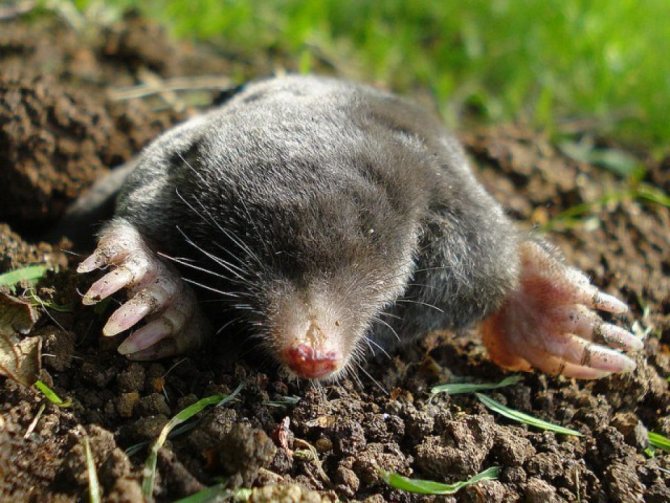

They get rid of moles on the site with the help of scarers
Strong and severe night frosts can seriously harm the platycodon, so do not rush to land in open ground. If, nevertheless, it was not possible to comply with the disembarkation period, the withered parts are cut off. Perhaps the plant will be able to heal.
Platycodon will bloom only under properly organized living conditions. Lack of top dressing will lead to the fact that the flowers will lag behind in growth. They will have small leaves and few inflorescences.
Note! If the plant begins to dry, then this indicates a lack of moisture. In this case, all damaged parts must be removed, and the bells themselves must be watered abundantly.
An excess of moisture leads to decay of the root system. This is due to the lack of a drainage system. A layer of expanded clay or broken brick leads to the fact that excess moisture is not retained. Root decay can be determined by lethargy of leaves and stems. The plant must be carefully dug up and, if the roots are rotten, then the specimen is destroyed. After that, the remaining plants are watered less frequently.
Platicodon: planting and care
Grouse flower: planting and care after flowering
When working with platycodon, planting and care in the open field must be carried out in accordance with all established requirements.
Seed planting
To grow Platycodon they resort to sowing. Pre-soaking of seeds is not required. The plant will bloom fully. To make the plant happy in the coming summer, the seeds can be sown in the fall.Resistant to low temperatures. The first shoots will appear in the spring.
In the spring, when the earth warms up to seven degrees, you can also sow Platicodon seeds. Since bells take a very long time to sprout, it is best to sow them in a well-lit area. Do not choose areas under the crown of trees or in the shade.
Planting seedlings
For growing seedlings, seeds are sown in April in a greenhouse to maintain an optimal temperature of 15-17 ℃ above zero. The first shoots appear after 20 days. Sprouts are planted in open ground only after a month.
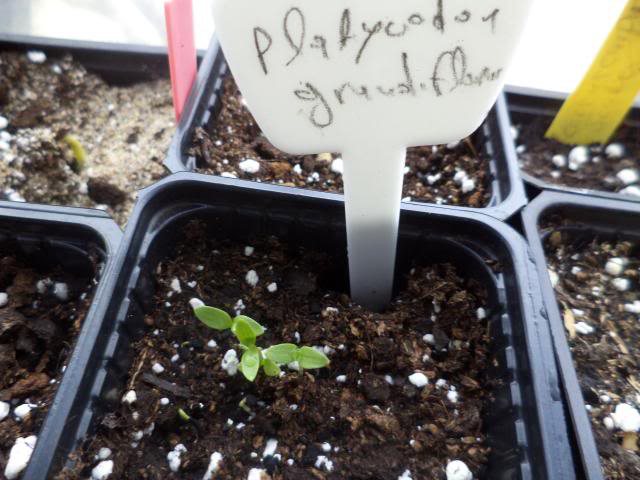

Platycodon planting
Wintering
Platycodon can be an annual flower if desired. In this case, after the flowering period, all plants are dug up and destroyed. But with a properly organized rest period, the bells will bloom next year.
Note! Platycodon is a perennial flower. In mid-October, you need to trim the entire aerial part. You can collect seed pods that contain seed.
Old shoots must be removed so that the plant can tolerate frosts more easily. From above, the planting is covered with spruce branches, foliage or sand. With this approach, wintering will be easy.
In the spring, new shoots are expected to appear, after which the earth is carefully loosened. In doing so, it is important not to damage the fragile root system. For reproduction, it is better to use harvested seeds.
In indoor conditions, wintering is carried out a little differently. The flower pot is transferred to a cool room (no more than 10 ° C), after which the amount of watering is reduced and the daylight hours are reduced.
Indoors, all varieties tolerate wintering well. The rest period allows the plants to gain strength for a new flowering. Platycodon varieties from seeds or seedlings grow well in a room.
Care features
In the first days after transplanting, you need to take very high quality care of the plant, water it daily. When the platycodon gets used to the new conditions, watering can be reduced to once every two days. When the soil is moistened, loosen the soil and remove weeds if mulch is missing.
It is important to ensure that water does not stagnate around the bushes after watering, otherwise the plant will rot in a short time. But the flower will not tolerate overdrying either.
Once a month, you need to add a special fertilizing in the form of a complex fertilizer. When 2 years of growth have passed, the bushes will begin to stretch. To make them compact again, you need to purchase a growth blocker. If you do not want to use chemicals, you need to pinch the plants on time.
Elongated shoots can be tied to a support or to each other so that the plant does not lose its decorative features. To increase the flowering period, wilted and old flowers are best pruned.
Diseases and pests
One of the main advantages of the plant is its immunity to various diseases. The root system can be damaged by mice or moles. To get rid of them, you need to use the following methods:
- Place traps with poisoned cereals throughout the site. But this method will get rid of mice only on its own site.
- For the extermination of rodents, it is advisable to blow smoke into the hole. Use a rubber hose that is attached to the exhaust pipe of, for example, a chainsaw. The free end will need to be placed directly into the burrow. With the help of smoke, it will turn out to smoke absolutely all the moles from the territory.
There are situations when gray rot forms on the platycodon. This disease spreads if the soil is too moist. Plants that are planted in poorly drained soil can also suffer from this ailment. To get rid of this trouble, you need to regularly loosen the soil around the planting.
If this method does not work, then the bushes must be treated with a solution called Topsin-m or Fundazol. The latter is applied in two percent form.After 10 days, processing will need to be repeated.
Growing Platicodone from seeds
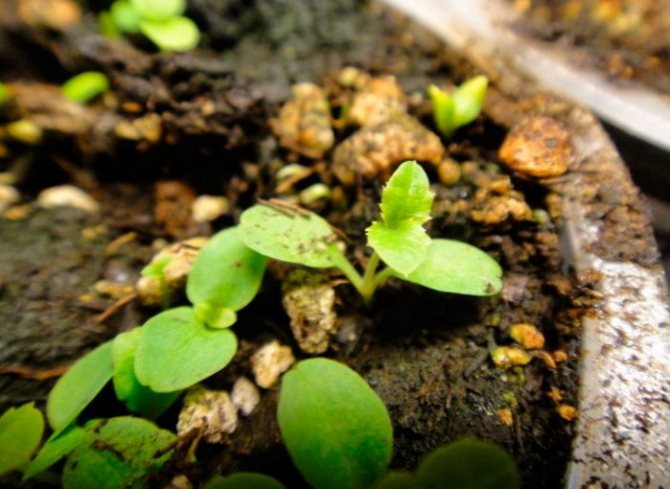

Very often, gardeners choose the generative (seed) method for reproduction of Platycodon. Seeds can be sown directly into open soil in spring or before winter, but experts advise growing such a plant through seedlings. Sowing seeds for seedlings is recommended to be done in the last days of February or the first - in March. Before starting sowing, the seeds must be prepared. To do this, they are poured into a bag of gauze and placed in a not very large vessel filled with water, where they must stay for two days. For sowing seeds, it is recommended to use large flowerpots or boxes, which must be filled with an earth mixture consisting of humus, peat soil and sand (1: 1: 1). The substrate must be well loosened, and then Platicodon seeds are laid out on its surface. There are 2 different opinions about embedding the seed in the ground, so one of the gardeners claims that it is not necessary to bury the seeds, while the rest say that they need to be sprinkled with a thin (0.3 to 0.5 cm thick) layer of sand. When sowing is finished, the substrate should be moistened with water at room temperature using a spray bottle. Cover the container on top with a film, and then transfer it to a warm place (from 20 to 22 degrees). It is necessary to water the crops only after the top layer of the substrate dries up. The first seedlings should appear 7-15 days after sowing.
How to care for seedlings


It is necessary to care for the growing seedlings of Platycodon in exactly the same way as for the seedlings of other garden flowers. When the first seedlings appear, the shelter must be removed, while the container itself is rearranged to a cooler place (from 18 to 20 degrees). Seedlings should be watered only when necessary. After each watering, be sure to very carefully loosen the soil in the container. After the seedlings have 3 or 4 true leaves, they will need to be picked into individual pots with a diameter of about 10 centimeters. Flowers will grow in these containers until they are planted.
Platycodon sowing
You can grow platycodon on your site from seeds. In early September, seeds are sown in a prepared groove with loose soil. Sowing is sprinkled with a 2-3 cm layer of compost, well watered and mulched. In May-June of the next year, the first shoots appear from the seeds. Platycodon is transplanted to a permanent place in the fall or next spring. Platicodon develops slowly and blooms only for 2-3 years.
To obtain seedlings, Platicodon seeds are sown in planting boxes in late March - early April. Before planting, the seeds are stratified for at least 3 months. The seed is evenly distributed on the prepared soil substrate. The earth is lightly tamped and watered. In addition, you do not need to sprinkle the sowing with earth. The future seedlings are watered and covered with foil. Shoots appear on the 10-14th day. They are not watered, but sprayed from a spray bottle. Seedlings are kept at a temperature of + 15 ° C. After 2-3 true sheets appear, the film is removed.


Platycodon seedlings are planted in a permanent place at the end of May, but before that stratification is required. The distance between plants is at least 15-20 cm. The bed should be well lit by the sun. It does not tolerate excess moisture in the soil, therefore, to increase the air permeability of the soil, gravel or coarse sand is laid in the hole before planting. After planting the seedling, the soil is mulched with compost or peat.
At home, fertilizing is carried out at the beginning and middle of summer. Before winter, the platycodon bush is cut off, and the roots of the plant are covered with fallen leaves.
Features of growing at home
The culture is also grown at home. For this, the seeds are immediately planted in pots in which the bushes will grow. Planting is no different than outdoor seeding. When the seedlings grow up, they can be transplanted (if the bushes grow too close to each other). It is recommended to place the pots on sunny windows.
The features of care also do not differ from the street ones. Unless the soil can be weeded. The culture feels great at home in pots. Blooms profusely under favorable conditions.
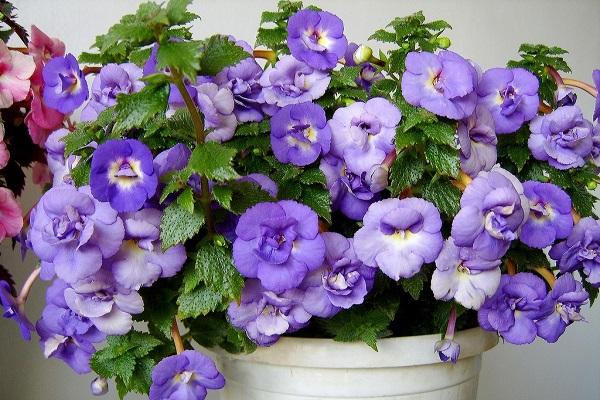

Platicodon propagation by cuttings
Other methods of propagation, such as cuttings and dividing the bush, are unreliable, and if the cuttings can still be taken, then dividing the bush almost never gives the desired results.
To use propagation by cuttings, you need to cut off shoots with a pair of internodes and a heel from the shoot.
Further, the procedure is the same as with cuttings of other plants - germination of roots in water or sand and planting in a pot until the end of development.
to the table of contents
Platicodon after flowering
Seed collection
When the box inside the flower cracks, it will be possible to understand that the seeds are ripe. Seed collection is carried out only after the pedicels are completely dry (usually in September). Absolutely new varieties can grow from seeds collected with their own hands, while the flowers of such plants will have an unusual color.
Preparation for wintering
This flower is a perennial. In this regard, in autumn, its aboveground part must be completely cut off, and the surface of the site must be covered with a thick layer of mulch (humus, dried foliage, peat, sawdust or spruce branches).

